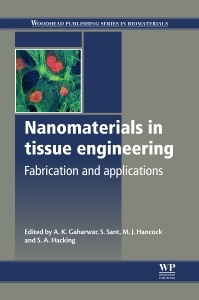Description
Nanomaterials in Tissue Engineering
Fabrication and Applications
Woodhead Publishing Series in Biomaterials Series
Language: English
Subject for Nanomaterials in Tissue Engineering:
468 p. · 15.5x23.2 cm · Hardback
Description
/li>Contents
/li>Biography
/li>Comment
/li>
Part one focuses on the fabrication of nanomaterials for tissue engineering applications and includes chapters on engineering nanoporous biomaterials, layer-by-layer self-assembly techniques for nanostructured devices, and the synthesis of carbon based nanomaterials. Part two goes on to highlight the application of nanomaterials in soft tissue engineering and includes chapters on cardiac, neural, and cartilage tissue engineering. Finally, the use of nanomaterials in hard tissue engineering applications, including bone, dental and craniofacial tissue engineering is discussed in part three.
Nanomaterials in tissue engineering is a standard reference for researchers and tissue engineers with an interest in nanomaterials, laboratories investigating biomaterials, and academics interested in materials science, chemical engineering, biomedical engineering and biological sciences.
Contributor contact details
Woodhead Publishing Series in Biomaterials
Foreword
Introduction
Chapter 1: Biomedical nanomaterials in tissue engineering
Abstract:
1.1 Introduction
1.2 Overview of nanomaterials in tissue engineering
1.3 Biomedical nanomaterials in tissue engineering applications
1.4 Future trends
Part I: Fabrication of nanomaterials for tissue engineering applications
Chapter 2: Synthesis of polymeric nanomaterials for biomedical applications
Abstract:
2.1 Introduction
2.2 Types of polymers used in nanomaterials
2.3 Synthesis of polymeric nanoparticles
2.4 Synthesis of polymeric scaffolds
2.5 Characterization of the nanomaterials
2.6 Future trends
Chapter 3: Engineering nanoporous biomaterials
Abstract
3.1 Introduction
3.2 Nanotubes and etched nanoporous surfaces
3.3 Self-assembled supramolecular organic templates
3.4 Self-assembled colloidal templates
3.5 Conclusion
Chapter 4: Layer-by-layer self-assembly techniques for nanostructured devices in tissue engineering
Abstract:
4.1 Introduction
4.2 Interaction between biomaterials as ingredients for multilayer formulations
4.3 Scalability to three dimensions
4.4 Application of nanostructured multilayer devices in tissue engineering
Conclusion
Chapter 5: Synthesis of carbon based nanomaterials for tissue engineering applications
Abstract:
5.1 Introduction
5.2 Carbon nanotubes and fibers
5.3 Fullerenes (C60)
5.4 Graphene
5.5 Nanodiamond systems
5.6 Carbon-nanostructured materials
5.7 Conclusion
Chapter 6: Fabrication of nanofibrous scaffolds for tissue engineering applications
Abstract:
6.1 Introduction
6.2 Methods for nanofibrous scaffolds fabrication
6.3 Surface modification of nanofibrous scaffolds
6.4 Applications of nanofibrous scaffolds in tissue engineering
6.5 Conclusion
Chapter 7: Fabrication of nanomaterials for growth factor delivery in tissue engineering
Abstract:
7.1 Introduction
7.2 Strategies for controlled growth factor delivery in tissue engineering
7.3 Nanostructures for growth factor delivery in tissue engineering
7.4 Nanofibers
7.5 Nanoparticles
7.6 Strategies for dual growth factor, drug and gene delivery
7.7 Clinical prospective of nanostructures with growth factor delivery in tissue engineering
7.8 Conclusion and future trends
Part II: Application of nanomaterials in soft tissue engineering
Chapter 8: Nanomaterials for engineering vascularized tissues
Abstract:
8.1 Introduction
8.2 Biocomplexity of vascularized tissues
8.3 Engineering nanomaterials to improve vascularization of tissues
8.4 Clinical progress
8.5 Conclusion and future trends
Chapter 9: Nanomaterials for cardiac tissue engineering
Abstract:
9.1 Introduction
9.2 Heart muscle structure and diseases
9.3 Cardiac tissue engineering (CTE)
9.4 Application of nanomaterials and nanofabrication methods in CTE
9.5 Case study: magneto-mechanical cell stimulation to promote CTE
9.6 Conclusion and future trends
9.7 Acknowledgements
Chapter 10: Nanomaterials for neural tissue engineering
Abstract:
10.1 Introduction to neural tissue engineering
10.2 Nano-scaffold design techniques
10.3 Nano-structures
10.4 Biomaterials for scaffold design
10.5 Drawbacks of the use of nanomaterials
10.6 Conclusion and future trends
10.7 Acknowledgements
Chapter 11: Nanomaterials for cartilage tissue engineering
Abstract:
11.1 Introduction
11.2 Cartilage biology and structure
11.3 Clinical approaches in the treatment of cartilage defects
11.4 Nanomaterials: strategies for cartilage regeneration
11.5 Conclusion
Chapter 12: Biomaterials and nano-scale features for ligament regeneration
Abstract:
12.1 Introduction
12.2 Anterior cruciate ligament (ACL) composition, structure and properties
12.3 Injury, healing and treatment of the ACL
12.4 Engineered scaffold materials for ligament regeneration
12.5 Methods for enhancing engineered scaffolds for ligament regeneration
12.6 Conclusion and future trends
Part III: Application of nanomaterials in hard tissue engineering
Chapter 13: Nanomaterials for hard–soft tissue interfaces
Abstract:
13.1 Introduction
13.2 Nanoparticles
13.3 Nanofibers
13. 4 Strategies incorporating nanomaterials in hard–soft tissue interfaces
13 5 Conclusion and future trends
Chapter 14: Mineralization of nanomaterials for bone tissue engineering
Abstract:
14.1 Bone: a nanobiocomposite material
14.2 Collagen as a biomaterial
14.3 Approaches to the mineralization of collagenous constructs
14.4 Conclusion
Chapter 15: Nanomaterials for dental and craniofacial tissue engineering
Abstract:
15.1 Introduction
15.2 Nanotechnology for engineered substrates
15.3 Engineering mineralized collagenous craniofacial structures
15.4 Nano-scale scaffolds with integrated delivery systems
15.5 Micro/nano-arrays as libraries for high-throughput characterization
15.6 Conclusion
Index
Dr Shilpa Sant is an Assistant Professor in the Department of Pharmaceutical Sciences, School of Pharmacy and Department of Bioengineering at the University of Pittsburgh, USA. She is also an affiliate faculty member at McGowan Institute for Regenerative Medicine, Pittsburgh, USA.
Dr Matthew J. Hancock is a research scientist at Broad Institute, USA.
Dr Adam A. Hacking is the director of the Laboratory for Musculoskeletal Research and Innovation (LMRI) in the Department of Orthopaedics at the Massachusetts General Hospital and Harvard Medical School, USA.
- Explores the fabrication of a variety of nanomaterials and their use across a range of tissue engineering applications
- Examines engineering nanoporous biomaterials, layer-by-layer self-assembly techniques for nanostructured devices, and the synthesis of carbon based nanomaterials
- Highlights the application of nanomaterials in soft tissue engineering and includes chapters on cardiac, neural, and cartilage tissue engineering
These books may interest you

Musculoskeletal Tissue Engineering 222.81 €



